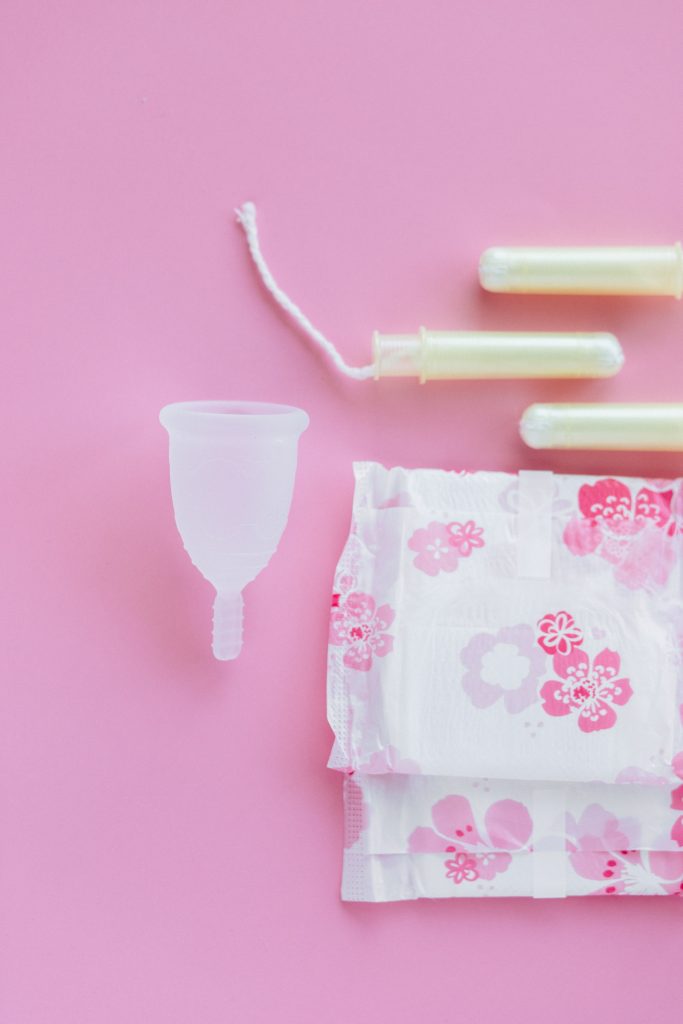
The most familiar stage of a female’s menstrual cycle is the period. A period is characterized by bleeding from the vagina that lasts approximately three to seven days. Menstrual products provide feminine hygiene by collecting or absorbing blood. There are countless different methods and products that provide this hygienic benefit. The most commonly used menstrual products are menstrual pads, tampons, and menstrual cups. The decision to use one menstrual product over another is based on personal preference.
Table of Contents
Menstrual Pads
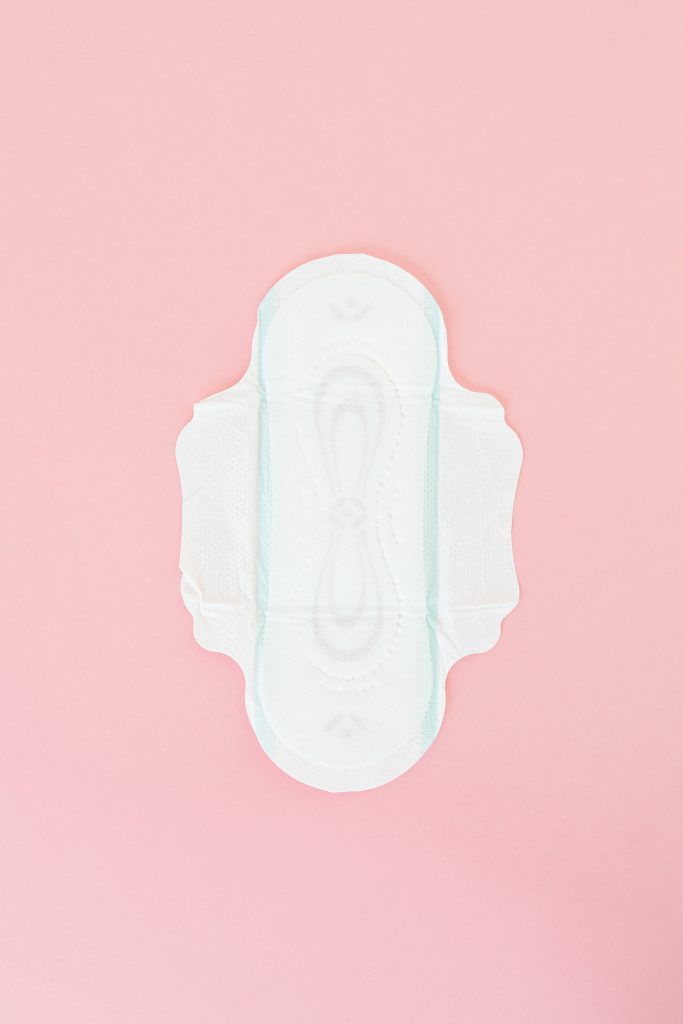
A menstrual pad (also referred to as a sanitary napkin) is a thin piece of absorbent material that is placed in a female’s underwear to absorb the menstrual flow after it exits the body.1 Pads come in many different shapes and sizes and range from light absorbency to high absorbency to handle every stage of a female’s period. These products are typically disposed of after a few hours (approximately four to eight) or once moderately saturated.1 Pads are safe to wear overnight, carry no risk of toxic shock syndrome (TSS), and are generally very reliable so long as the pad is placed correctly in the underwear and is the appropriate level of absorbency for a female’s menstrual flow on a particular day. Menstrual pads are a great resource for females who recently began their monthly periods.
Using Pads
To use a menstrual pad, simply peel off the adhesive backing and place the pad in your underwear. The sticky side of pad should attach to your underwear, while the absorbent side faces up toward your body.
Advantages and Disadvantages of Pads
Menstrual pads are very easy to use. They are also discreet and disposable, making them ideal for females who are new to menstruation. Pads stay outside the body so they are safe to wear overnight, carrying no risk of toxic shock syndrome. Menstrual pads are also reliable, inexpensive, and highly accessible.
Despite their advantages, menstrual pads can sometimes be physically uncomfortable or may be visible through clothing. Pads may also become odorous if they are not changed frequently.
Although menstrual pads can be uncomfortable at times, they are a valuable resource for females who prefer inexpensive, widely accessible, easy-to-use menstrual products. Pads are also ideal for females who do not wish to have any products inside their bodies.
Tampons
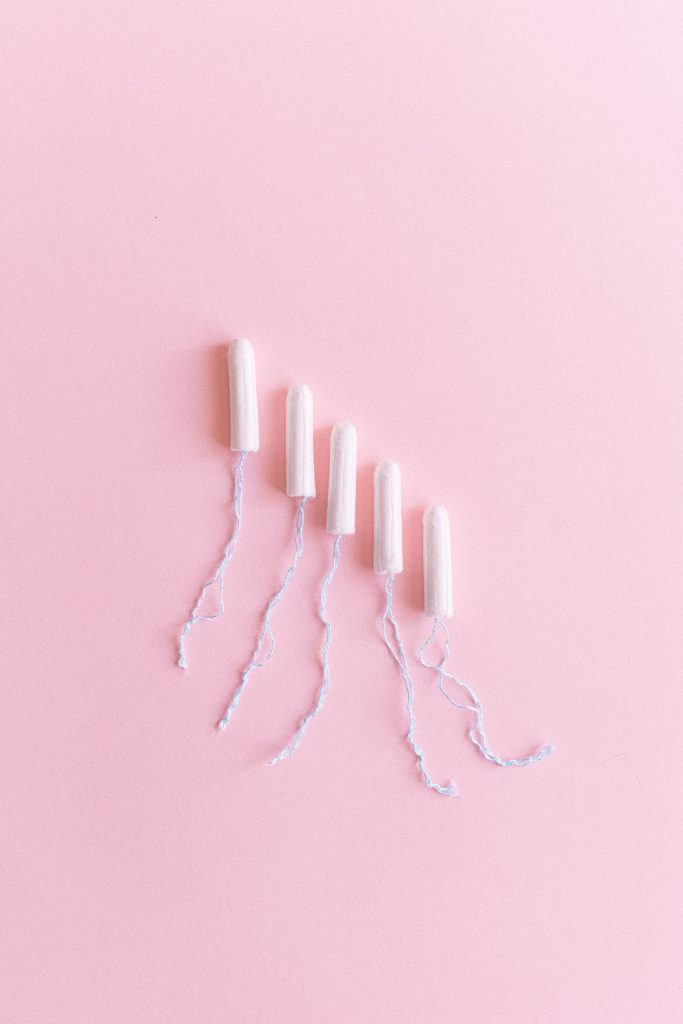
A tampon is a small, cylinder-shaped piece of absorbent material that is inserted into the vagina to absorb menstrual flow. Most tampons have a small cotton string that hangs outside the body to allow for easy removal by pulling down on the string. Many tampons also come with plastic or cardboard applicators for easy insertion according to the directions included with the product. Tampons are inserted into the body to absorb the menstrual flow before it exits the body. Like pads, tampons come in a variety of sizes and levels of absorbency.
It is important to use tampons safely because they are inserted into the body. There has been some controversy over the safety of tampons. Toxic shock syndrome (TSS) has been linked to the use of tampons. In the United States (U.S.), tampons are approved and regulated by the Food and Drug Administration (FDA). Each box sold in the U.S. provides information and instructions on how to reduce one’s risk of TSS. Using tampons correctly can severely reduce this risk.
Using Tampons
The most important thing to remember when using tampons is to change them frequently, around every four-to-six hours. Do not leave a tampon inside the vagina for more than eight hours. Try to use the lowest absorbency tampon that you need, especially on days when your menstrual flow is lighter (often occurring at the beginning and ending of the menstruating period). Every female’s menstrual cycle is unique. By paying attention to their menstrual cycle, one can become more aware of the nature of their flow and how frequently they will need to change their tampon in order to be safe. If one notices that the tampons they are using do not become saturated, switch to a smaller size. The lower the absorbency level of a tampon, the lower risk of toxic shock syndrome.
Instructions for Inserting/Removing a Tampon with a Built-In Applicator:2
- Wash your hands before unwrapping the tampon.
- Find a comfortable position. Many women insert their tampons while sitting on the toilet, squatting, or standing with one leg resting on the edge of the toilet or tub. The exact position does not matter as much as making sure the muscles surrounding the vagina are relaxed, allowing for easier insertion of the tampon.
- Locate the vaginal opening and slowly and gently insert the applicator into the opening, at an angle directed towards your lower back. Continue to push the applicator in until your fingers touch your body and the applicator is all the way inside.
- While still holding the applicator inside the body, use your index finger to slowly push the inner tube toward the body. This step pushes the actual tampon into the body.
- Once the inner tube is pushed in all the way, pull the applicator out and dispose of it.
- To remove a tampon, wash your hands and then gently pull the string until the tampon exits the body.
Instructions for Inserting/Removing a Tampon without a Built-In Applicatior:2
- Wash your hands before unwrapping the tampon.
- Find a comfortable position. Many women insert their tampons while sitting on the toilet, squatting, or standing with one leg resting on the edge of the toilet or tub. The exact position does not matter as much as making sure the muscles surrounding the vagina are relaxed, allowing for easier insertion of the tampon.
- Locate the vaginal opening and slowly and gently insert the tampon into the vaginal opening, at an angle directed at the lower back. Continue to push the tampon in until your fingers touch your body and the tampon is all the way inside, with the string hanging outside the body.
- To remove a tampon, wash your hands and then gently pull the string until the tampon exits the body.
After inserting, the string should be visibly hanging outside the body and the tampon should feel comfortable and not noticeable. If you experience pain during insertion or once the tampon is inside the body, you may want to pull the tampon out, re-wash your hands, and try again. If the pain persists, it may be necessary to use a menstrual pad. Remember that every box of tampons contains instructions on how to use that particular product, so before using a tampon, consult the instruction manual provided for maximum safety.
Advantages and Disadvantages of Tampons
Tampons are easy to use; however, they can be difficult to learn how to use for the first time. Like pads, tampons are discreet and disposable, but tampons are usually more comfortable if inserted properly and cannot be seen through clothing. They are also inexpensive and accessible. Tampons absorb menstrual flow before it exits the body, thus, tampons typically do not become odorous.
Tampons can be dangerous if used incorrectly. They cannot be worn overnight and must be changed very frequently because they carry the risk of toxic shock syndrome (TSS). If a female is interested in using tampons, she must also be comfortable with inserting the tampon into the body.
Tampons can be very convenient and comfortable; however, their insertion into the body makes them somewhat dangerous compared to other menstrual products.
Reusable Pads and Tampons
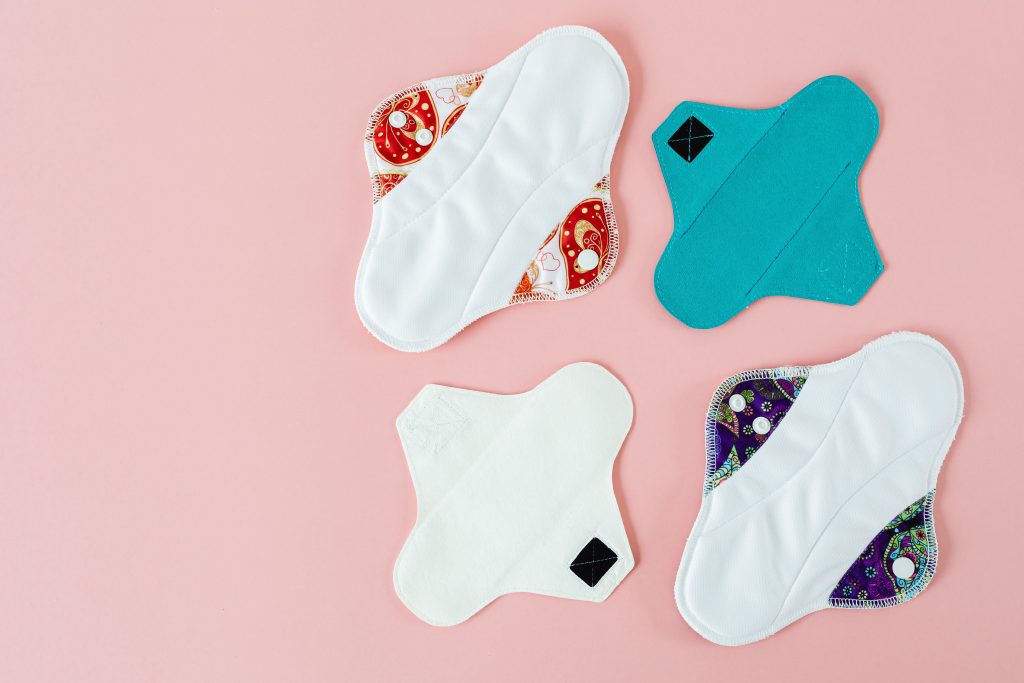
Despite the convenience of disposable pads and tampons, many feel that it is not worth the waste and negative environmental impact created by the disposable materials. Similarly, not everyone can afford to purchase disposable pads and tampons or access them easily on a regular basis. For these reasons, some females choose to use cloth menstrual pads or reusable tampons, which can be washed after every use.
The advantages and disadvantages of reusable menstrual pads and tampons are roughly equivalent to their disposable counterparts. The main advantage of reusable menstrual products is the decreased negative environmental impact and decreased cost in the long run. The main disadvantage is the inconvenience of having to handle and wash the used product.
The Menstrual Cup
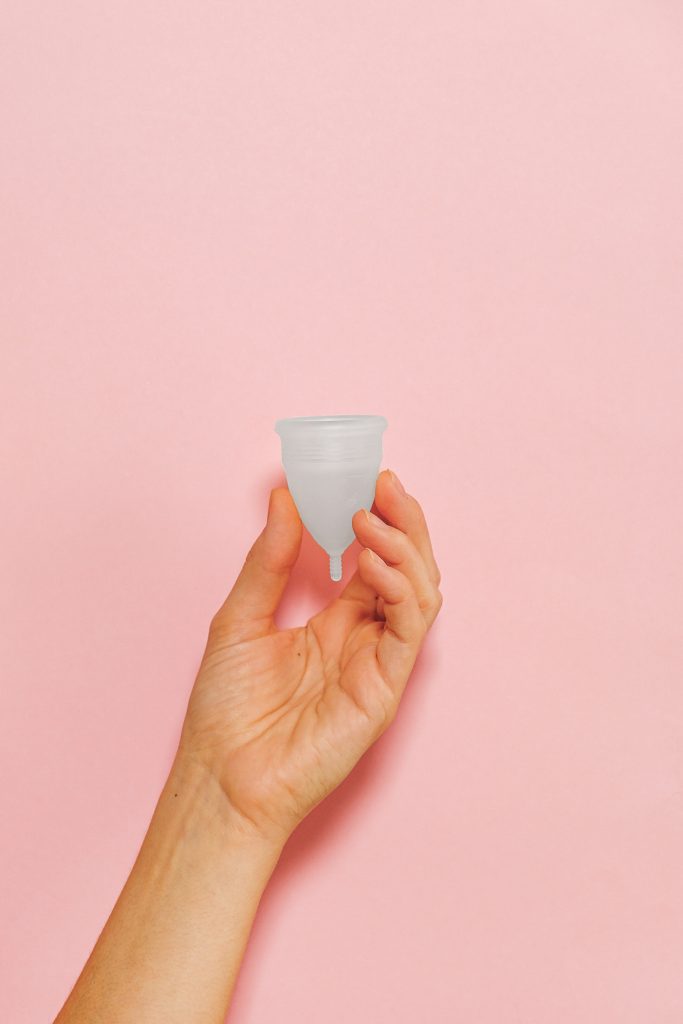
The menstrual cup is a small bell-shaped piece of flexible medical-grade silicone that is inserted into the vagina to collect menstrual flow as it exits the cervix and before it leaves the body. The main difference between pads/tampons and the menstrual cup is that the menstrual cup is not made of absorbent material. Instead, it catches and holds the flow. It is safe to leave a menstrual cup inside the body for roughly 12 hours before it needs to be removed because it is made out of silicone instead of cotton. The material from which the cup is made is also highly durable, lasting up to 10 years. Therefore, menstrual cups are less expensive over time because there is no need to continuously repurchase products. They generally come in two sizes, one for females who have not yet given childbirth and one for females who have.
Females who want to try using a menstrual cup should be comfortable with their bodies and their bodily fluids, since they will be handling them intimately.
Using a Menstrual Cup
To insert a menstrual cup, it is very important to wash both your hands and the cup. To wash the cup, it is best to use a gentle soap with no fragrance. Rinse off the cup completely and remove all traces of soap before inserting to reduce the risk of contracting a yeast infection.
Brief instructions on how to insert the cup properly are listed below, but it is important to consult with the directions provided with the menstrual cup before inserting for the first time.
- Wash your hands and menstrual cup thoroughly.
- Get into a comfortable position in which your pelvic muscles are relaxed completely. Tense muscles can make insertion difficult. Many females have found that their pelvic floor muscles are the most relaxed after urinating, thus they choose to insert/remove their menstrual cup at this time.
- Fold the menstrual cup into a “C-fold” shown here by pressing into the middle of the cup with your finger and folding the sides in toward the middle. This orientation will allow for easier insertion.
- Make sure you maintain the C-fold while slowly and gently inserting the cup into the vagina, aiming toward the lower back. Continue pressing until your fingers touch your body.
- Once the cup is inserted into the vagina, make sure it has fully opened by feeling the base or twisting it in a circle.
In order to remove the cup, locate the stem at the base of the cup. You may want to pinch the base of the cup to break the suction. Slowly pull on the stem until the cup is completely outside the body. After removing the cup, empty it in the sink, shower, or toilet. Many companies recommend boiling the cup in hot water between periods to keep it sanitary.
Some females notice a small amount of blood that comes out when they are using a menstrual cup, and thus they opt to use panty liners simultaneously. This blood does not mean the menstrual cup is leaking; it is usually the result of a small amount of blood being trapped between the menstrual cup and the vaginal canal upon insertion. Do not panic if your first experience using a menstrual cup is not perfect. Inserting the menstrual cup can be more difficult than other methods, and it may take several tries to find the right technique.
Advantages and Disadvantages of the Menstrual Cup
The menstrual cup is very safe for both the body and the environment. It also absorbs flow before leaving the body, is comfortable if inserted properly, and cannot be seen through clothes.
The menstrual cup can be difficult to learn how to use and some females may feel uncomfortable with inserting the product into the body. Typically menstrual cups have a high one-time cost, but are relatively inexpensive over time. Menstrual cups are also relatively inaccessible compared to other menstrual products.
Menstrual cups are a great option for females who want a menstrual product that is very safe, reusable, and reliable; however, it can be difficult to use correctly.
Products for Menstrual Side Effects
Many females experience negative side effects during their monthly periods. Symptoms include acne, pre-menstrual syndrome (PMS), heavy bleeding, irregular cycles, cramps, aches, and fatigue. Premenstrual syndrome, more commonly referred to as PMS, ia the set of symptoms associated with the beginning of a female’s monthly period. Symptoms of PMS include lethargy, sadness, headaches, lack of sexual desire, cramps, general aching, and fatigue.3 Moderate exercise, foods high in potassium such as bananas, and a variety of vitamins and minerals can help alleviate cramps, while cutting back on salty foods helps with water retention and bloating Many females who experience severe PMS seek treatment for their pain. If your menstrual cycle is causing you great discomfort, it may be a good idea to see a doctor. Prescription drugs and over-the-counter medications are available to help alleviate pain and regulate cycles.
The Pill
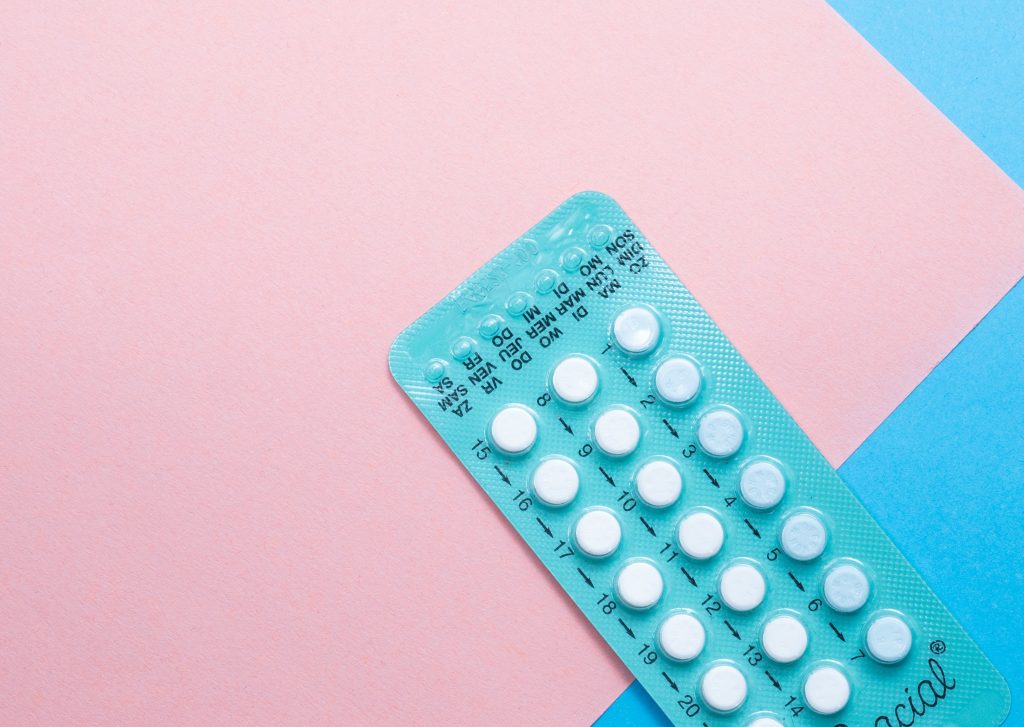
Some females who experience adverse symptoms during their periods turn to oral contraceptives to control the side effects. Oral contraceptives consist of hormones that can reduce these side effects. Some brands can reduce the frequency of periods or eliminate them altogether. An example of such a pill is Seasonique.
Advantages and Disadvantages of the Pill
The birth control pill can alleviate some of the more severe side effects of a female’s period. Birth control pills typically require prescriptions, making them less accessible and typically more expensive than other menstrual products. The pill also exposes the body to hormones, such as estrogen.
The pill as a menstrual product is not for everyone. Oral contraceptives can cost up to $30 a month and have varying hormonal side effects. Additionally, many do not have easy access to oral contraceptives. However, for females whose periods negatively impact their day-to-day life, this method can be a beneficial option. Additionally, many health insurance companies cover birth control in their plans.
Midol
“Midol” is a popular over-the-counter drug designed to relieve menstrual cramping and other period-related discomfort. Midol is taken by mouth when a female experiences negative side effects from her period. Unlike other over-the-counter painkillers, Midol is aimed toward alleviating all menstrual-related side effects, including fatigue and bloating.4 Although there are a few different types of Midol on the market today, they all contain some combination of painkillers, such as ibuprofen, acetaminophen, or naproxen sodium. There are also forms of Midol that contain caffeine to address fatigue and a diuretic to decrease bloating.
Advantages and Disadvantages of Midol
Midol alleviates most of the negative PMS symptoms and is available over-the-counter. Options such as “Midol Teen” or Midol with caffeine address different females’ needs, but the diuretics and caffeine contained in Midol can be problematic if used in excess.
Concluding Remarks
There are hundreds of different products designed specifically to improve the experience of menstruation. The above-mentioned techniques are by no means a comprehensive list of all menstrual products on the market today. The vast variety of options reflects the individuality of every female’s period. One product does not fit all needs and it is up to a female to decide what works best for her and her body.
References
- What is a Sanitary Pad? Menstupedia: 2017.
- Using Your First Tampon. Center for Young Women’s Health: 2016.
- Premenstrual Syndrome (PMS). Mayo Clnic: 2014.
- About Midol. LiveStrong.com: 2015.
Last Updated: 18 May 2017.
